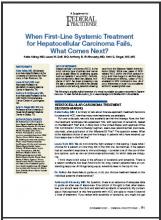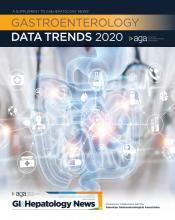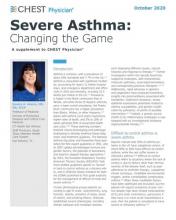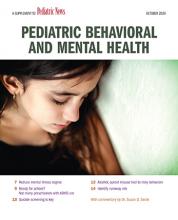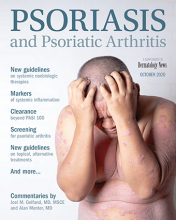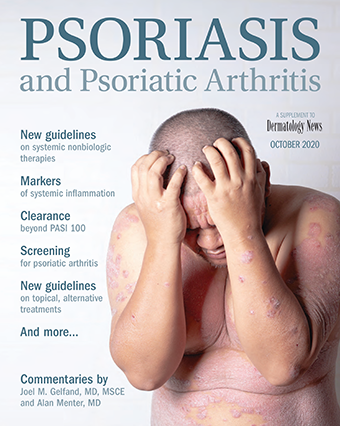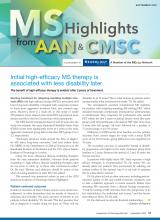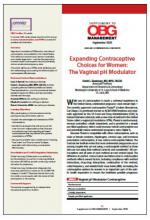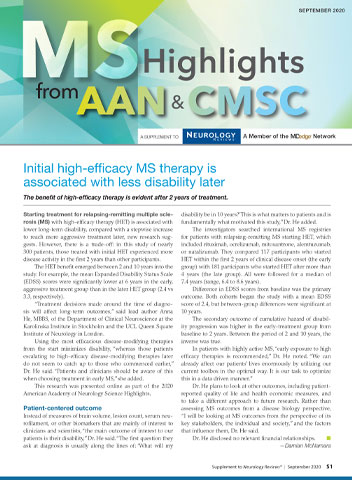User login
When First-Line Systemic Treatment for Hepatocellular Carcinoma Fails, What Comes Next?
The following is a lightly edited transcript of a virtual roundtable discussion recorded in September 2020. To view the full discussion, go to www.mdedge.com/FedPrac/HCC-Roundtable.
The following is a lightly edited transcript of a virtual roundtable discussion recorded in September 2020. To view the full discussion, go to www.mdedge.com/FedPrac/HCC-Roundtable.
The following is a lightly edited transcript of a virtual roundtable discussion recorded in September 2020. To view the full discussion, go to www.mdedge.com/FedPrac/HCC-Roundtable.
Gastroenterology Data Trends 2020
Topics include:
Long-Term Impact of COVID-19 on the Practice of Gastroenterology and Endoscopy
John I. Allen, MD, MBA, AGAF
Consolidation Trends in Gastroenterology
Michael Weinstein, MD, AGAF
IBD Management Amid COVID-19
Kim L. Isaacs, MD, AGAF
Racial and Social Disparities in Gastroenterology
Sandra M. Quezada, MD, MS
Impending Physician Shortages in Gastroenterology
Michael Weinstein, MD, AGAF
Recommendations for Colonoscopy and the Management of Large Polyps
Aasma Shaukat, MD, MPH, AGAF
Nonalcoholic Steatohepatitis (NASH): Identifying Patients with High-Risk Disease
Brent Tetri, MD, AGAF
Esophageal Adenocarcinoma: Geographical Clustering and Time Trends
Joel Rubenstein, MD, MSc
Topics include:
Long-Term Impact of COVID-19 on the Practice of Gastroenterology and Endoscopy
John I. Allen, MD, MBA, AGAF
Consolidation Trends in Gastroenterology
Michael Weinstein, MD, AGAF
IBD Management Amid COVID-19
Kim L. Isaacs, MD, AGAF
Racial and Social Disparities in Gastroenterology
Sandra M. Quezada, MD, MS
Impending Physician Shortages in Gastroenterology
Michael Weinstein, MD, AGAF
Recommendations for Colonoscopy and the Management of Large Polyps
Aasma Shaukat, MD, MPH, AGAF
Nonalcoholic Steatohepatitis (NASH): Identifying Patients with High-Risk Disease
Brent Tetri, MD, AGAF
Esophageal Adenocarcinoma: Geographical Clustering and Time Trends
Joel Rubenstein, MD, MSc
Topics include:
Long-Term Impact of COVID-19 on the Practice of Gastroenterology and Endoscopy
John I. Allen, MD, MBA, AGAF
Consolidation Trends in Gastroenterology
Michael Weinstein, MD, AGAF
IBD Management Amid COVID-19
Kim L. Isaacs, MD, AGAF
Racial and Social Disparities in Gastroenterology
Sandra M. Quezada, MD, MS
Impending Physician Shortages in Gastroenterology
Michael Weinstein, MD, AGAF
Recommendations for Colonoscopy and the Management of Large Polyps
Aasma Shaukat, MD, MPH, AGAF
Nonalcoholic Steatohepatitis (NASH): Identifying Patients with High-Risk Disease
Brent Tetri, MD, AGAF
Esophageal Adenocarcinoma: Geographical Clustering and Time Trends
Joel Rubenstein, MD, MSc
Severe Asthma: Changing the Game
In this supplement to CHEST Physician, Dr. Sandra Adams investigates the following topics:
- Difficult-to-control vs severe asthma
- T2-high inflammatory endotype
- T2-low endotype
- Biologic therapies in severe asthma
- Treatment follow-up and assessment
Click here to read.
Author
Sandra G. Adams, MD, MS, FCCP
Division of Pulmonary
Diseases and Critical Care Medicine
UT Health San Antonio
Staff Physician,
Care System
San Antonio, TX
In this supplement to CHEST Physician, Dr. Sandra Adams investigates the following topics:
- Difficult-to-control vs severe asthma
- T2-high inflammatory endotype
- T2-low endotype
- Biologic therapies in severe asthma
- Treatment follow-up and assessment
Click here to read.
Author
Sandra G. Adams, MD, MS, FCCP
Division of Pulmonary
Diseases and Critical Care Medicine
UT Health San Antonio
Staff Physician,
Care System
San Antonio, TX
In this supplement to CHEST Physician, Dr. Sandra Adams investigates the following topics:
- Difficult-to-control vs severe asthma
- T2-high inflammatory endotype
- T2-low endotype
- Biologic therapies in severe asthma
- Treatment follow-up and assessment
Click here to read.
Author
Sandra G. Adams, MD, MS, FCCP
Division of Pulmonary
Diseases and Critical Care Medicine
UT Health San Antonio
Staff Physician,
Care System
San Antonio, TX
PEDIATRIC BEHAVIORAL AND MENTAL HEALTH
- Reduce mental illness stigma
- Ready for school? Not many preschoolers with ADHD are
- Suicide screening is key
- Alcohol, opioid misuse tied to risky behaviors
- Identify runaway risk
- Reduce mental illness stigma
- Ready for school? Not many preschoolers with ADHD are
- Suicide screening is key
- Alcohol, opioid misuse tied to risky behaviors
- Identify runaway risk
- Reduce mental illness stigma
- Ready for school? Not many preschoolers with ADHD are
- Suicide screening is key
- Alcohol, opioid misuse tied to risky behaviors
- Identify runaway risk
Psoriasis and Psoriatic Arthritis
Psoriasis and Psoriatic Arthritis is a supplement to Dermatology News with commentary from Joel M. Gelfand, MD, MSCE and Alan Menter, MD.
- Exploring new guidelines and scientific advances
- ‘Loss-framed’ approach makes psoriasis patients more agreeable to treatment
- Topical PDE-4 inhibitor for psoriasis effective in phase 2b trial
- Biologics may delay psoriatic arthritis
- AAD-NPF releases guidelines for systemic nonbiologic treatments of psoriasis
- Specific markers detect psoriatic disease inflammation without elevated CRP
- Beyond PASI 100: Striving for molecular clearance
- Ultrasound improves specificity of psoriatic arthritis referrals
- Registry data reveal temporal relationship between psoriasis symptoms and PsA onset
- New psoriasis guidelines focus on topical and alternative treatments, and severity measures
- Psoriasis topical combination maintenance strategy hits mark at 1 year
Read the supplement.
Psoriasis and Psoriatic Arthritis is a supplement to Dermatology News with commentary from Joel M. Gelfand, MD, MSCE and Alan Menter, MD.
- Exploring new guidelines and scientific advances
- ‘Loss-framed’ approach makes psoriasis patients more agreeable to treatment
- Topical PDE-4 inhibitor for psoriasis effective in phase 2b trial
- Biologics may delay psoriatic arthritis
- AAD-NPF releases guidelines for systemic nonbiologic treatments of psoriasis
- Specific markers detect psoriatic disease inflammation without elevated CRP
- Beyond PASI 100: Striving for molecular clearance
- Ultrasound improves specificity of psoriatic arthritis referrals
- Registry data reveal temporal relationship between psoriasis symptoms and PsA onset
- New psoriasis guidelines focus on topical and alternative treatments, and severity measures
- Psoriasis topical combination maintenance strategy hits mark at 1 year
Read the supplement.
Psoriasis and Psoriatic Arthritis is a supplement to Dermatology News with commentary from Joel M. Gelfand, MD, MSCE and Alan Menter, MD.
- Exploring new guidelines and scientific advances
- ‘Loss-framed’ approach makes psoriasis patients more agreeable to treatment
- Topical PDE-4 inhibitor for psoriasis effective in phase 2b trial
- Biologics may delay psoriatic arthritis
- AAD-NPF releases guidelines for systemic nonbiologic treatments of psoriasis
- Specific markers detect psoriatic disease inflammation without elevated CRP
- Beyond PASI 100: Striving for molecular clearance
- Ultrasound improves specificity of psoriatic arthritis referrals
- Registry data reveal temporal relationship between psoriasis symptoms and PsA onset
- New psoriasis guidelines focus on topical and alternative treatments, and severity measures
- Psoriasis topical combination maintenance strategy hits mark at 1 year
Read the supplement.
MS Highlights from AAN & CMSC
- Initial high-efficacy MS therapy is associated with less disability later
- Serum NfL in early MS can help predict clinical course
- No benefit of three commonly used medications for MS fatigue
- Telerehabilitation may be effective in MS
- CMSC MRI guidelines evolve into international consensus protocol
- Newest oral DMTs haven’t yet made a big impact in the MS world
Read the supplement.
- Initial high-efficacy MS therapy is associated with less disability later
- Serum NfL in early MS can help predict clinical course
- No benefit of three commonly used medications for MS fatigue
- Telerehabilitation may be effective in MS
- CMSC MRI guidelines evolve into international consensus protocol
- Newest oral DMTs haven’t yet made a big impact in the MS world
Read the supplement.
- Initial high-efficacy MS therapy is associated with less disability later
- Serum NfL in early MS can help predict clinical course
- No benefit of three commonly used medications for MS fatigue
- Telerehabilitation may be effective in MS
- CMSC MRI guidelines evolve into international consensus protocol
- Newest oral DMTs haven’t yet made a big impact in the MS world
Read the supplement.
Expanding Contraceptive Choices for Women: The Vaginal pH Modulator
Vaginal pH modulators (VPMs) add a new class of contraception that is now available in the United States. This method is nonhormonal, woman-controlled, and coitally dependent—and has the potential to increase overall contraceptive use and potentially reduce unintended pregnancy rates.
This CME supplement to OBG Management focuses on VPMs, their attributes, and the methodology surrounding the determination of contraceptive effectiveness.
Vaginal pH modulators (VPMs) add a new class of contraception that is now available in the United States. This method is nonhormonal, woman-controlled, and coitally dependent—and has the potential to increase overall contraceptive use and potentially reduce unintended pregnancy rates.
This CME supplement to OBG Management focuses on VPMs, their attributes, and the methodology surrounding the determination of contraceptive effectiveness.
Vaginal pH modulators (VPMs) add a new class of contraception that is now available in the United States. This method is nonhormonal, woman-controlled, and coitally dependent—and has the potential to increase overall contraceptive use and potentially reduce unintended pregnancy rates.
This CME supplement to OBG Management focuses on VPMs, their attributes, and the methodology surrounding the determination of contraceptive effectiveness.
MS Highlights From the AAN & CMSC Annual Meetings
This supplement to Neurology Reviews compiles MS-related news briefs from the 2020 virtual annual meetings of the American Academy of Neurology and the Consortium of Multiple Sclerosis Centers.
This supplement to Neurology Reviews compiles MS-related news briefs from the 2020 virtual annual meetings of the American Academy of Neurology and the Consortium of Multiple Sclerosis Centers.
This supplement to Neurology Reviews compiles MS-related news briefs from the 2020 virtual annual meetings of the American Academy of Neurology and the Consortium of Multiple Sclerosis Centers.
Even in a virtual environment, the Society of Gynecologic Surgeons delivers without a “glitch”
Earlier this year, I was honored to serve as the Scientific Program Chair for the 46th Annual Scientific Meeting of the Society of Gynecologic Surgeons (SGS). This year’s meeting was the first ever (and hopefully last) “virtual” scientific meeting, which consisted of a hybrid of prerecorded and live presentations. Although faculty and attendees were not able to be together physically, the essence of the lively SGS meetings came through loud and clear. We still had “discussants” comment on the oral presentations and ask questions of the presenters. These questions and answers were all done live—without a glitch! Many thanks to all who made this meeting possible.
In addition to the outstanding abstract and video presentations, there were 4 superb postgraduate courses:
- Mikio Nihira, MD, chaired “Enhanced recovery after surgery: Overcoming barriers to implementation.”
- Charles Hanes, MD, headed up “It’s all about the apex: The key to successful POP surgery.”
- Cara King, DO, MS, led “Total laparoscopic hysterectomy: Pushing the envelope.”
- Vincent Lucente, MD, chaired “Transvaginal reconstructive pelvic surgery using graft augmentation post-FDA.”
Many special thanks to Dr. Lucente who transformed his course into a wonderful article for this special section of
One of our exceptional keynote speakers was Marc Beer (a serial entrepreneur and cofounder, chairman, and CEO of Renovia, Inc.), whose talk was entitled “A primer on medical device innovation—How to avoid common pitfalls while realizing your vision.” Mr. Beer has turned this topic into a unique article for this special section (see next month’s issue for Part 2).
Our TeLinde Lecture, entitled “Artificial intelligence in surgery,” was delivered by the dynamic Vicente Gracias, MD, professor of surgery at Robert Wood Johnson University Hospital, New Brunswick, New Jersey. We also held 2 live panel discussions that were very popular. The first, “Work-life balance and gynecologic surgery,” featured various perspectives from Drs. Kristie Green, Sally Huber, Catherine Matthews, and Charles Rardin. The second panel discussion, entitled “Understanding, managing, and benefiting from your e-presence,” by experts Heather Schueppert; Chief Marketing Officer at Unified Physician Management, Brad Bowman, MD; and Peter Lotze, MD. Both of these panel discussions are included in this special section as well.
I hope you enjoy the content of this special section of
Earlier this year, I was honored to serve as the Scientific Program Chair for the 46th Annual Scientific Meeting of the Society of Gynecologic Surgeons (SGS). This year’s meeting was the first ever (and hopefully last) “virtual” scientific meeting, which consisted of a hybrid of prerecorded and live presentations. Although faculty and attendees were not able to be together physically, the essence of the lively SGS meetings came through loud and clear. We still had “discussants” comment on the oral presentations and ask questions of the presenters. These questions and answers were all done live—without a glitch! Many thanks to all who made this meeting possible.
In addition to the outstanding abstract and video presentations, there were 4 superb postgraduate courses:
- Mikio Nihira, MD, chaired “Enhanced recovery after surgery: Overcoming barriers to implementation.”
- Charles Hanes, MD, headed up “It’s all about the apex: The key to successful POP surgery.”
- Cara King, DO, MS, led “Total laparoscopic hysterectomy: Pushing the envelope.”
- Vincent Lucente, MD, chaired “Transvaginal reconstructive pelvic surgery using graft augmentation post-FDA.”
Many special thanks to Dr. Lucente who transformed his course into a wonderful article for this special section of
One of our exceptional keynote speakers was Marc Beer (a serial entrepreneur and cofounder, chairman, and CEO of Renovia, Inc.), whose talk was entitled “A primer on medical device innovation—How to avoid common pitfalls while realizing your vision.” Mr. Beer has turned this topic into a unique article for this special section (see next month’s issue for Part 2).
Our TeLinde Lecture, entitled “Artificial intelligence in surgery,” was delivered by the dynamic Vicente Gracias, MD, professor of surgery at Robert Wood Johnson University Hospital, New Brunswick, New Jersey. We also held 2 live panel discussions that were very popular. The first, “Work-life balance and gynecologic surgery,” featured various perspectives from Drs. Kristie Green, Sally Huber, Catherine Matthews, and Charles Rardin. The second panel discussion, entitled “Understanding, managing, and benefiting from your e-presence,” by experts Heather Schueppert; Chief Marketing Officer at Unified Physician Management, Brad Bowman, MD; and Peter Lotze, MD. Both of these panel discussions are included in this special section as well.
I hope you enjoy the content of this special section of
Earlier this year, I was honored to serve as the Scientific Program Chair for the 46th Annual Scientific Meeting of the Society of Gynecologic Surgeons (SGS). This year’s meeting was the first ever (and hopefully last) “virtual” scientific meeting, which consisted of a hybrid of prerecorded and live presentations. Although faculty and attendees were not able to be together physically, the essence of the lively SGS meetings came through loud and clear. We still had “discussants” comment on the oral presentations and ask questions of the presenters. These questions and answers were all done live—without a glitch! Many thanks to all who made this meeting possible.
In addition to the outstanding abstract and video presentations, there were 4 superb postgraduate courses:
- Mikio Nihira, MD, chaired “Enhanced recovery after surgery: Overcoming barriers to implementation.”
- Charles Hanes, MD, headed up “It’s all about the apex: The key to successful POP surgery.”
- Cara King, DO, MS, led “Total laparoscopic hysterectomy: Pushing the envelope.”
- Vincent Lucente, MD, chaired “Transvaginal reconstructive pelvic surgery using graft augmentation post-FDA.”
Many special thanks to Dr. Lucente who transformed his course into a wonderful article for this special section of
One of our exceptional keynote speakers was Marc Beer (a serial entrepreneur and cofounder, chairman, and CEO of Renovia, Inc.), whose talk was entitled “A primer on medical device innovation—How to avoid common pitfalls while realizing your vision.” Mr. Beer has turned this topic into a unique article for this special section (see next month’s issue for Part 2).
Our TeLinde Lecture, entitled “Artificial intelligence in surgery,” was delivered by the dynamic Vicente Gracias, MD, professor of surgery at Robert Wood Johnson University Hospital, New Brunswick, New Jersey. We also held 2 live panel discussions that were very popular. The first, “Work-life balance and gynecologic surgery,” featured various perspectives from Drs. Kristie Green, Sally Huber, Catherine Matthews, and Charles Rardin. The second panel discussion, entitled “Understanding, managing, and benefiting from your e-presence,” by experts Heather Schueppert; Chief Marketing Officer at Unified Physician Management, Brad Bowman, MD; and Peter Lotze, MD. Both of these panel discussions are included in this special section as well.
I hope you enjoy the content of this special section of
